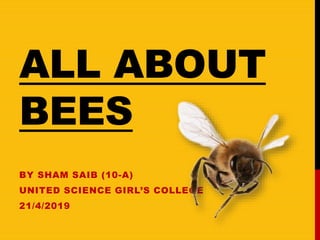
All about bees.pptx
- 1. ALL ABOUT BEES BY SHAM SAIB (10-A) UNITED SCIENCE GIRL’S COLLEGE 21/4/2019
- 2. SO, WHAT ARE BEES EXACTLY? Bees are flying insets closely related to wasps and ants. They come from the family Apoidea and they are divided into 9 other families >>> There are about 20,000 species out there. Bees have yellow/orange and black stripes on their bodies Bees have a haploid-diploid breeding system.
- 3. pollination: Bees feed on the nectar and pollen from the flower flowers reproduce by transferring pollen from the anthers to the stigma. Bees carry the pollen by their legs from flower to flower which results in genetic diversity. This means, the interaction between bees and flowers is a mutualistic relationship. BEES ARE GREAT POLLINATORS
- 4. HOW BEES LOCATE FLOWERS 1. A bee’s sense of direction is by their sense of smell. 2. Bees communicate to each other by the waggle dance.
- 5. 2 MAJOR TYPES OF BEES 1)SOLITARY BEES 2) COMMUNAL BEES
- 6. Solitary bees live alone. solitary bees are all female. They don’t produce bees wax or honey. They live in holes in the wood, in the ground or in hollow twigs Examples; carpenter bees, leafcutter bees and mason bees. SOLITARY BEES
- 7. COMMUNAL BEES • They share a nest together and live in colonies • The most common types are; bumble bees, stingless bees and honey bees.
- 8. Honey bees make honey. They can make colonies as large as 80,000 bees. They are the number one pollinator insects on the planet. Each bee has a specific role in the colony, which is divided into 3 roles: HONEY BEES
- 9. 1) THE QUEEN BEE Female 2cm’s big Can live up to 5 years There can be only one queen in a colony. It’s role is to produce eggs and send chemical signals to guide the bees
- 10. 2) THE DRONES 3)THE WORKERS Drones are male bees Their role is to fertilize the queen. They only live during the spring and summer Worker bees are females They take up 98% of the hive. They do the most work, they look for pollen, protect the hive, clean, circulate air and make the honey.
- 11. HOW HONEY BEES MAKE HONEY Worker bees make honey from the nectar of flowers. worker bees store that nectar in their “honey stomach”. Worker bees digest this nectar in their stomach by it’s enzymes. Then the worker bee throws up this substance into another bees mouth, then the other bee does the same thing again and The cycle continuous until the honey is ready. The bees store the honey in one of their “cells”. They harden the honey and seal it afterwards.
- 12. THE IMPORTANCE OF BEES Why are bees important : 1/3 of our crops are pollinated by bees, such as,( cotton, apples, onions, cherries, tomatoes, coffee …etc.) Plants that are pollinated by bees are the foundation of terrestrial food chains. If bees go extinct, we would go extinct a few years later.
- 13. HOW TO HELP BEES In the last several years scientists and farmers have noticed that the population bees have decreased dramatically, about 50% actually and this is because of different factors such as: Pesticides like neonicotinoids cause the bees to die or forget memory and leave the hive. Parasites like (varroa destructor, paenibacillus, acarapis woodi) live inside the hive and kills the bees easily. Lack of flowers because of pollution, climate change, drought, habitat destruction and much more things that humans do. How do WE prevent this? Stop using pesticides and other dangerous chemicals. Grow more flowers. Support your local bee keepers. Protect the environment.